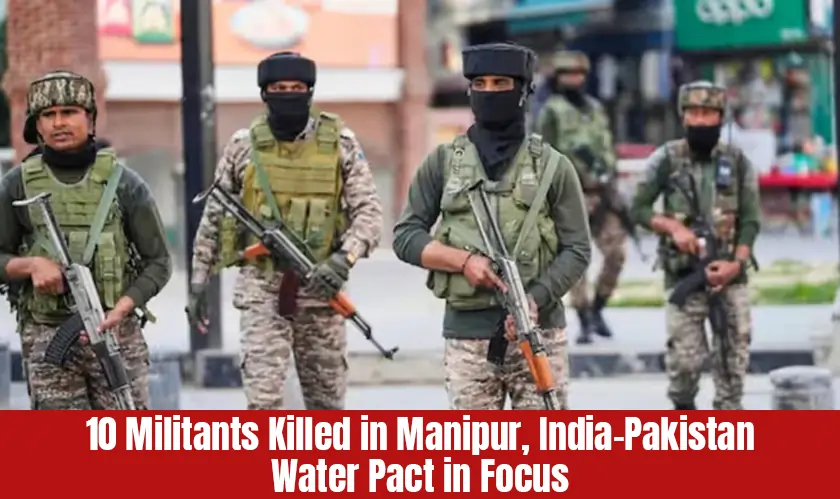Home Industry Defence technology 10 Militants Killed in Manipur...
Defence Technology

CIO Bulletin
16 May, 2025
In a recent surge of violence in Northeast India, 10 militants killed in a clash with Assam Rifles in Manipur’s Chandel district near New Samtal village close to the Indo-Myanmar border. Armed militants attacked Indian Army soldiers from the Spear Corps, which made army officials launch a quick response to take back the weapons and also show that security is still a big concern in the area.
This incident is just one example of a yearlong problem with violence in the area, which has led to many people being hurt, forced out of their homes, and more differences between different groups. Additionally, another clash in Jiribam resulted in many militants killed and injured. As tensions rise, the government is spending significant effort making sure the country stays safe on the inside while dealing with issues from other countries.
On May 14, 2025, Indian Army troops in the eastern region took action and killed 10 out of the 12 militants killed in New Samtal village. The Assam Rifles, part of the Spear Corps, had a gun battle with armed rebels. Although the militants remain unidentified, their sophisticated weapons indicate they are a formidable group attempting to instigate chaos in the area. The operation, started after getting good information, is a big win against threats in a border area where insurgents are active.
On May 12, soldiers and insurgents had a clash at a CRPF camp in Jiribam, Manipur, and 10 militants killed in the fighting. CRPF personnel got injured and had to be taken to the hospital. In Imphal East, people have been attacking farmers with guns over the past few days, and one person got injured because of it. This growing wave of violence against civilians is making people in these places even more afraid, especially those who have lost homes or been hurt in the fighting. More militants killed in strikes that hit civilians could make local people even more scared.
In close partnership with the Assam Rifles, police discovered and seized a large amount of weapons in Churachandpur and Kangpokpi districts. Seized items included rifles, guns, rocket launchers, grenades, and ammo, which show that the militant groups are getting better-armed and have a lot of supplies with them. The Assam Rifles units were there during the raids and helped stop any planned attacks. The finding of IEDs also makes people concerned that there might be more attacks on public places and military vehicles. This discovery matches what intelligence is now saying—that militant groups are remaking themselves and getting ready to keep fighting in the hills. It is predicted that more people fighting from different sides will be militants killed in these upcoming attacks as the rate of clashes increases.
Amid internal unrest in India, Pakistan is asking India to follow an agreement from the 1960s that’s meant to share water between the two countries. India’s choice to end the treaty has been called “one-sided” and “not allowed” by Pakistan. This appeal comes at the same time as India’s Operation Sindoor, and Pakistan is worried that the military action could hurt farmers and make it hard for them to plant their crops ahead of the sowing season.
The Indian government keeps saying that it can't work with other countries if they still support terrorism. Officials say that the Indus Waters Treaty cannot work if Pakistan keeps using terrorism as a way of doing things. Citing climate change and old dam designs, Indian authorities say it is time to revise the treaty because things have changed since the agreement was signed.
Prime Minister Modi saying “blood and water can’t mix” shows that India wants to stick by its tough position. As a result, the treaty's suspension looks like a signal from India and Pakistan about both countries' efforts to fight terrorism and work together on water issues.
Adding fuel to the fire are fresh reports saying that the Indian army hit some key nuclear-related spots in Pakistan. Although the government and the IAEA have said there were no radiation leaks, people around the world are still hearing and sharing reports about possible radiation problems. The IAEA said clearly that there wasn’t any radiation leak or nuclear issue in Pakistan, so people shouldn’t be worried.
India has said that their military strikes were routine and did not go after nuclear sites. Nevertheless, the talk and speculation around these events have made the situation tenser between the two countries, especially since Pakistan has brought up India’s actions and positions in international meetings.
At the same time, Jammu and Kashmir is going through challenges, and what happened in Manipur during the elections is now making headlines. After the incident in Shopian, where three militants killed by the armed forces, the police and army came into conflict with them again in Tral, Awantipora. These militants killed were directly involved in the attack in Pahalgam, where 26 people were killed. Counterterror efforts continued across districts in response, aiming to identify militants killed in future encounters as members of organized sleeper cells. In the aftermath, the Indian Army found a big stockpile of weapons, proving that Operation Keller had indeed worked well. These back-to-back successes in the Northeast and Kashmir show India is determined to stop militant activity.
Amid rising unrest and attempts to settle down tensions, the Supreme Court’s April 8 decision on whether or not the president really needs to give assent to state laws has led to a new round of discussion. President Droupadi Murmu has brought up concerns about the way Article 143(1) of the Constitution may be used by courts and said it could lead to too much judicial power. This legal development makes India’s political situation more complicated, as issues around federalism, who has power, and keeping the country safe all come together.
With Indian Army news in the news and ongoing violence in the northeast, India is dealing with several problems both from within and from other countries.
Conclusion
The 10 militants killed in Manipur and the ongoing tensions in the Northeast show that security in the area is still pretty unstable. Intensified fights near the Indo-Myanmar border make India’s security forces keep a close watch and stay ready. Even more, problems with the Indus Waters Treaty between India and Pakistan do not help either country come together. India needs to work on strengthening its defense, handle security issues, deal with local problems, and try to sort out shared water issues both inside the country and with other countries.
FAQs
1. What happened in Manipur recently?
Security forces managed to kill 10 militants after a clash in the area around New Samtal village
2. Where did the CRPF camp attack happen?
The attack happened in Jiribam district of Manipur, where CRPF troopers and a number of militants killed.
3. What is the Indus Waters Treaty?
A 1960 agreement set out how India and Pakistan should share the waters of the Indus River between them.
4. Who carried out Operation Sindoor?
The Indian Air Force attacked important terrorist bases on the Pakistan side of Kashmir.
5. Is there any official report of radiation leak happening in Pakistan?
No, the IAEA said they didn't find any leak of radiation.







